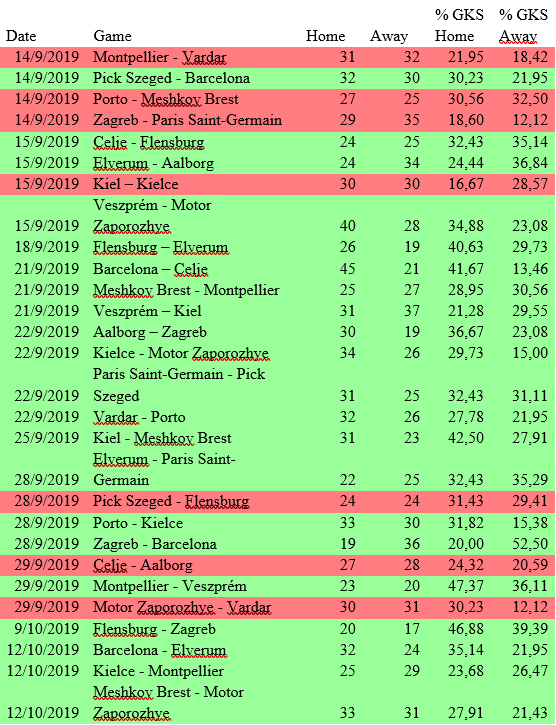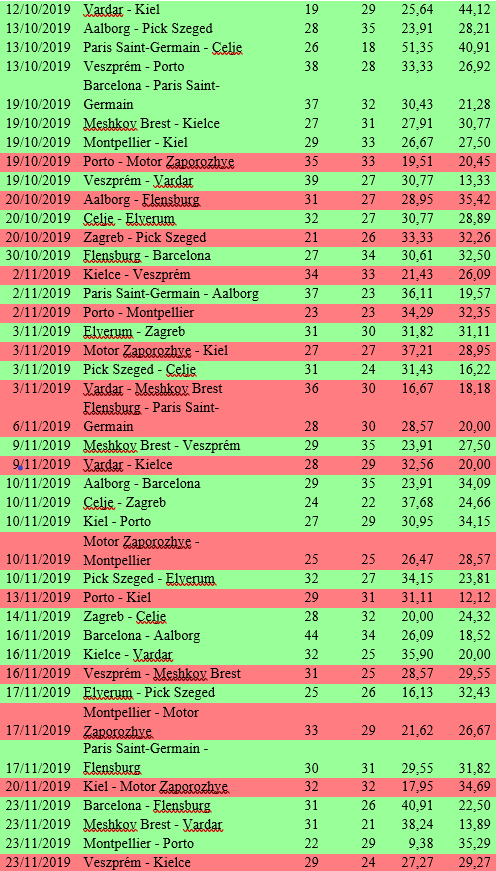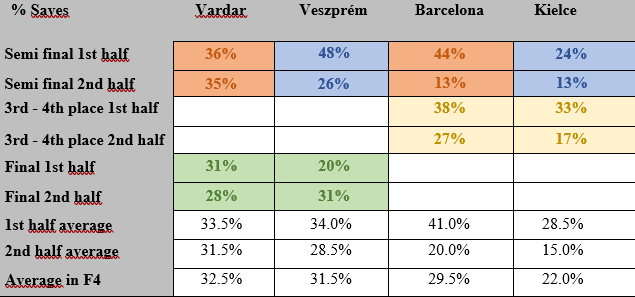Influence of the Goalkeepers into Final Score

EHF CHAMPIONS LEAGUE
In summary
Among the most trendy opinions and views into nowadays’ handball, it’s so usual to hear about how important goalkeepers’ performance are in regards to the final score of a single game or even a whole competition, both from club or national teams or at European or world level.
Over the last years, goal-keepers’ training has impressively raised the bar, especially when it comes to a more specific and individually tailored approach and with an increasing presence of video analytics as well, whose exclusive feedback can be easily leveraged and therefore allow them to push up their chances to make a difference into the final score of the games.
The present work is based on a sample of 112 games, belonging them to groups A and B from VELUX EHF Champions League group phase. Out of this data we’ll try to figure out how strongly linked are these two variables: goal-keepers’ accuracy and teams’ success at the end of the games.
1. Introduction
VELUX EHF Champions League it’s the main clubs competition played in Europe, joining the 24 best teams among the whole European handball scene. The competition flows as explained in the following points:
- Teams are splitted out in 2 groups of 8 teams (A and B) and 2 ones of 6 (C and D).
- Groups A and B: Both are disputed under a double round-robin basis, which means 14 fixtures. The winners of each group will qualify directly to quarter finals whereas runners- up from 2nd to 6th position will qualify to Last16. 7th and 8th will be eliminated.
- Groups C and D: Double round-robin too, 10 fixtures in this case. Once this league is completed, the first two teams from each group will go through a qualifying round, in which the winners of each group will play a knock-out round against the second one from the other group. The two winners will gain the right to move on to Last16.
- Last16: From here onwards the whole competition changes its shape from round-robin to knock-out style. Last16 reunites the following 12 teams:
- 5 coming from Group A (2nd, 3rd, 4th, 5th and 6th).
- 5 coming from Group B (2nd, 3rd, 4th, 5th and 6th).
- 2 winners from Groups C and D knock-outs.
All them will be placed into 6 duels of two legs each one. The one who scores more goals after both games will qualify for the next round. In the event of a tie, it will be broken firstly after an extra game and, if tie persists, victory will be decided after a 7-meters shootout.
The 6 winners will go through and meet with Groups A and B champions into the Quarter Finals.
- Quarter Finals: The remaining eight teams will get paired into 4 duels. Everything will work in the same manner as in Last16 and the 4 winners will meet into the Final Four.
- Final Four: The 4 qualified teams will meet in Lanxess Arena in Cologne (Germany) to play semifinals, 3rd-place match and final in a single weekend which will decide who’s the new European champion. Aside of the neutral scenario, the only significant change is that knock- outs will switch from a double-leg basis into a single-leg one. Due to Covid-19 crisis, this current season 2019/2020 it’s been decided the two first classified teams on groups A and B to qualify directly to the Final Four since it became impossible to find room into the calendar to place all the fixtures that would be necessary if we were to follow with the regular flow.
There are a bunch of studies that determine victory and defeat when high performant teams are involved do depend on some key offensive and defensive actions which are especially relevant, such as the ones from Pokrajac (2008), Taborsky (2008), Daza (2010), Montoya (2010) or Lozano (2012).
To illustrate how important goal-keepers accuracy is commonly considered among professionals, let’s take a look on what happened with former FC Barcelona’s goal-keeper Daniel Saric:
It was into 2014 Final Four when playing FC Barcelona against SG Flensburg-Handewitt, the formers wasted a 7-goals gap on the last ten minutes of the game, allowing the latters to come back and firstly equalize with a Holger Glandorf’s buzzer-beater and finally win the game after two extra games and a penalty shootout, making this game one of the most remembered among handball fans worldwide.
Once the game finished, Saric broke down in tears while being interviewed and stated “I’ve played and awful game, I didn’t stop a ball, I owe my club this trophy”. A year passed and 2015 Final Four came. FC Barcelona was once again in Cologne with Saric defending its goal. He played a superb role stopping a huge deal of Veszprém’s shoots during the final game, contributing dramatically into FC Barcelona’s final victory.
The usual purpose of these kind of inquiries is to determinate what’s the quantitative contribution from certain game features into some collective actions on elite handball teams. All this information is meaningful when it’s time to design tactical or strategical approaches allowing us to optimize its performance.
Once the game finished, Saric broke down in tears while being interviewed and stated “I’ve played and awful game, I didn’t stop a ball, I owe my club this trophy”. A year passed and 2015 Final Four came. FC Barcelona was once again in Cologne with Saric defending its goal. He played a superb role stopping a huge deal of Veszprém’s shoots during the final game, contributing dramatically into FC Barcelona’s final victory.
1.1. Goal
The goal of this study is to statistically determine whether the goal-keepers’ specific role, measured in saves accuracy percents makes a difference as believed or not. We’ll only analyze this variable. The investigation will be quantitative, using the observational method.
1.2. Hypothesis
Our baseline hypothesis is that goalkeepers saves percentage is critical when it comes to determine the final result of a competition.
2. Method
In this observational-notational nature study, the data were compilated through the observation of a bunch of 112 games corresponding to all the matches from VELUX EHF Champions League 2019/2020 groups A and B, being supported too by the official reports published by the EHF. We’ll get the GK’s accuracy percentages from each one of these games, both for the whole 60 minutes of each one and broken down onto their two periods, in order for us to be able to infer more accurate insights and conclusions.
3. Results
3.1. Group Phase. Groups A and B.
Look at the table below in order for you to be able to check on each one of the games analysed. Each row contains information about when was each match disputed (column ‘Date’), which were the teams involved (‘Game’), what was the final score (‘Home’ and ‘Away’ columns), and what was the overall accuracy from each teams’ goal-keepers (columns ‘% GKS Home’ and ‘% GKS Away’).
In order to make the table more insightful, find highlighted in green all the games in which the final score matched my initial hypothesis whereas those in which this did not happen are highlighted in red.




3.1. Final Four. Qualified teams’s specific analysis.
3.2.1. Final Four 2020.
Firstly, we’ll take a glimpse at the GK saves accuracy among all the teams taking part into this group phase on the chart below. The teams highlighted in green are the ones who got qualified for the Final Four.

As per the chart, we can easily check that 3 out of the top-4 teams in terms of GK saves percentage gained their right to be in Cologne. Only THW Kiel got a significantly lower figure than their upcoming opponents in Final Four 2020.
3.2.2. Final Four 2019.
3.2.2.1 Results
| Game | Final | 1st half | 2nd half |
| 1st semi final FC Barcelona – HC Vardar | 27-29 | 16-9 | 11-20 |
| 2nd semi final Telekom Veszprém – PGE Vive Kielce | 33-30 | 13-13 | 20-17 |
| 3rd – 4th place FC Barcelona – PGE Vive Kielce | 40-35 | 20-16 | 20-19 |
| Final HC Vardar – Telekom Veszprém | 27-24 | 16-11 | 11-13 |
3.2.2.2. GK saves accuracy breakdown by game and period.

As per the chart, it seems crystal clear how much relevant the goal-keepers’ performance were in each game, especially in Vardar games. Both in their comeback on the second half against Barcelona on semi finals or along the first period against Veszprém as well, the huge gap between Vardar’s goalkeepers performance compared to Barcelona or Veszprém ones are strongly correlated with how the score evolved in both games.
3.3. Global insights
Summing up the main facts we’ve came across over all our analysis, these are the most relevant facts found.
- 81 out of 112 games were won by the team whose goal-keepers got the higher accuracy percentage.
- 39% accuracy: Every time the goalkeepers from any given team did surpass this threshold, their team always won the game. This fact took place in 22 occasions.
- 5% gap: Whenever the gap between the goalkeepers accuracy from both teams in the court was equal or higher than this figure, the teams whose goalkeepers were more effective did won 82% of the times this condition came into play.
- GK accuracy has played a key role for the leading teams on group phase to gain its qualification towards Final Four 2020.
- GK accuracy came up as a major fact for the last Final Four 2019 to be decided in favour of Vardar.
4. Discussion
Several works and studies had taken place over the past decades about the importance of goal-keepers role in handball, such as:
- Suter (1975), Menéndez Falkowski and Enríquez (1979), Konig (1981), Román (1981), Torres Todibio (1983), Pokrajac (1985) and Antón (1990) reflected about its training specificities according to their singular role.
- Closer on time, on season 2004/2005 the French Handball Federation published an article compilating the views about the matter and its singularities from some of the best goalkeepers from the 90’s decade such as Mats Olsson or Bruno Martini.
Perceptive and decisional approach has gained a lot of interest over the last decade. Velandrín (2004) and Pascual and Peña (2006) published its investigations on this subject, proving that enhancing goalkeepers’ perceptive-decisional skills is key in order to make a difference into their performance, and that their training tasks should focus more on the tactical approach based on this facts rather than a traditional technical-based approach, which should be a complement to the former.
5. Conclusions
As a result of all my analysis, the main conclusions I take away from it are the following ones:
Goalkeepers accuracy…
- … is key for any team to be successful in an elite competition such as EHF Champions League is.
- … can gain even a major relevance when top teams are opposed to each other in the event of top contests such a Final Four is too.
- … reduce the likelihood of a defeat to the lowest level:
- ….as much as it gets close to reach high figures, and makes it impossible from 39% upwards.
- …as bigger is the gap between both teams playing on this feature.
Therefore, any efforts to do in order to improve goalkeeper’s specific training in order to increase their performance are really likely to make a difference into their team’s success on elite competitions.
6. Bibliographic References
- ANTON GARCIA , JUAN (1990), Metodología de la enseñanza de los porteros en el proceso de aprendizaje del Balonmano .
- FALKOWSKI ,M Y ENRIQUEZ ERNESTO (1979) Estudio monográfico del portero.
- Konig ,Bedrig El entrenamiento de porteros en la practica ; libro diputación de Granada (1981)
- POKRAJAC ,Branislav ; El entrenamiento del portero Art /libro Unisport 1985
- ROMAN SECO ,JUAN DE DIOS , Artículo el Potero diputación de Granada (1981)
- Suter ,Heinz El portero de Balonmano /Libro INEF 1975
- TORRES TODIBIO ,Gabriel , EL Trabajo de agilidad con porteros con porteros (1983)
- GARDIEN DE BUT DE HANDBALL. L’ANALYSE ET LE TRAVAIL Editeur FFHB ( Año 2004-2005 ) Bruno Matini, Mats Olsson ,Alain Portes ,Andrei Lavrov( Dan unas reflexiones sobre la especifidad del portero.
- Caridad Vizcay Medina , Revista Digital -Buenos Aires N.145 ( JUNIO 2010)
- Antúnez A, Ureña ,Velandrin, (2004) Valoración de la efectividad de la interceptación con éxito de la portera de Balonmano ante el lanzamiento tras la aplicación de un programa perceptivo-motor
- Revista Internacional de Medicina y Ciencias de la Actividad Física y el deporte (2015)
- Pascual X, Peña R (2006) El portero de balonmano una aplicación práctica de entrenamiento perceptivo -decisional ante lanzamiento de primera linia , Apunts E.Fisica y Deportes pag 66-75
David Aguilar Cardona, Ehf Master Coach


